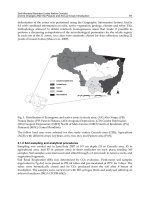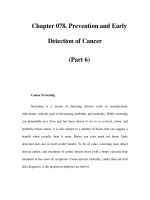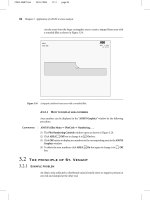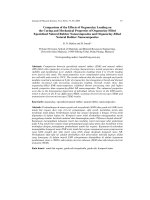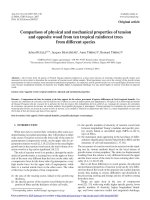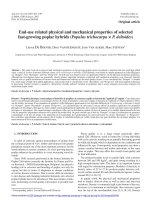Materials Science and Engineering - Electronic and Mechanical Properties of Materials Part 6 pps
Bạn đang xem bản rút gọn của tài liệu. Xem và tải ngay bản đầy đủ của tài liệu tại đây (343.84 KB, 10 trang )
3.225
7
Use of Minority Carrier Diffusion Equations
• Example: Light shining on a surface of a semiconductor
hν
G at x=0 (assume infinite
absorption coefficient to simplify
example)
G
p
x
p
D
t
p
h
h
+
∆
−
∂
∆∂
=
∂
∆∂
τ
2
2
n-type
∆p(x)?
0
Steady state solution
=0 in bulk
x
hh
hh
axax
axax
axax
hh
D
a
D
BeAe
BeaAea
BeAep
D
p
x
p
τ
τ
τ
1
22
2
2
=
+
=+
+=∆
∆
=
∂
∆∂
−
−
−
try
Now use boundary conditions of the problem:
hh
D
x
Bep
A
px
τ
−
=∆
=
∴
=∆∞=
0
0,@
Units of length:
minority carrier
diffusion length, L
h
h
L
x
h
h
h
eGp
GB
Gpx
−
=∆
=
∴
=∆=
τ
τ
τ
,0@
∆p
x
Gτ
h
x
p
eDJ
hh
∂
∆∂
=
© E. Fitzgerald-1999
3.225
8
Semiconductor Electronics
• Single crystalline - largely Si
some III - V compounds
• Dominated by many nearly identical, highly engineered junctions
• DRAMS (today) ≈ 10
9
transistors
• Microprocessors (2002) ≈ 10
8
transistors
•Total ≈ 10
18
yr ≈ 10
6
/person/day
© H.L. Tuller, 2001
4
3.225
9
Junction Fabrication Processes
© H.L. Tuller, 2001
3.225
10
CMOS Devices
© H.L. Tuller, 2001
5
3.225
11
The p-n Junction (The Diode)
• Note that dopants move the fermi energy from mid-gap towards either the
valence band edge (p-type) or the conduction band edge (n-type).
p-type material in equilibrium
n-type material in equilibrium
p~N
a
n~N
d
n~n
i
2
/N
a
p~n
i
2
/N
d
+=
C
d
bgF
N
N
TkEE ln
−=
V
a
bF
N
N
TkE
ln
E
c
E
c
E
F
E
v
E
F
E
v
What happens when you join these together?
© E. Fitzgerald-1999
3.225
12
-
-
+
+
+
+
Holes diffuse
Electrons diffuse
+
+
+
+
-
-
-
-
+
+
+
+
-
-
+
+
+
+
An electric field forms due to the fixed nuclei in the lattice from the dopants
Therefore, a steady-state balance is achieved where diffusive
flux of the carriers is balanced by the drift flux
E
Drift and Diffusion
© E. Fitzgerald-1999
6
7
3.225
13
Joining p and n
E
c
E
F
E
v
p
n
Carriers flow under driving force of diffusion until E
F
is flat
-
-
+
+
+
+
Holes diffuse
Electrons diffuse
© E. Fitzgerald-1999
3.225
14
-
-
+
+
+
+
-
-
+
+
+
+
W: depletion or space charge width
Metallurgical junction
ρ
E
V
V
bi
dx
x
E
∫
=
ε
ρ
)(
dxxEV
∫
= )(
pand
xNxN
=
x
p
x
n
)(
2
ada
dbior
p
NNN
N
e
V
x
+
=
εε
)(
2
add
abior
n
NNN
N
e
V
x
+
=
εε
ad
dabior
NN
NN
e
V
W
+
=
εε2
Space Charge, Electric Field and Potential
© E. Fitzgerald-1999
1
What is the built-in voltage V
bi
?
E
c
E
F
E
v
p
n
eV
bi
=E
Fn
-E
Fp
−=
−=
dV
i
b
V
n
bFn
NN
n
Tk
N
p
TkE
2
lnln
−=
−=
V
a
b
V
bFp
N
N
Tk
N
p
TkE lnln
=
∴
2
ln
i
dab
bi
n
NN
e
Tk
V
We can also re-write these to show that eV
bi
is the barrier to minority carrier injection:
Tk
eV
np
b
bi
enn
−
=
Tk
eV
pn
b
bi
epp
−
=
n
n
n
p
p
n
p
p
eV
bi
eV
bi
© E. Fitzgerald-1999
Qualitative Effect of Bias
• Applying a potential to the ends of a diode does NOT increase current through
drift
• The applied voltage upsets the steady-state balance between drift and
diffusion, which can unleash the flow of diffusion current
• “Minority carrier device”
E
c
E
F
E
v
n
n
n
p
p
n
p
p
eV
bi
eV
bi
Tk
VVe
np
b
abi
enn
)(
−−
=
Tk
VVe
pn
b
abi
epp
)(
−−
=
+eV
a
-eV
a
© E. Fitzgerald-1999
2
Current Flow - Recombination, Generation
© H.L. Tuller, 2001
• Forward bias (+ to p, - to n) decreases depletion region, increases diffusion
current exponentially
• Reverse bias (- to p, + to n) increases depletion region, and no current flows
ideally
E
c
E
F
E
v
n
n
n
p
p
n
p
p
eV
bi
-e|V
a
|
Qualitative Effect of Bias
E
c
E
F
E
v
n
n
n
p
p
n
p
p
eV
bi
+e|V
a
|
eV
bi
-e|V
a
|
eV
bi
+e|V
a
|
Forward Bias
Reverse Bias
+
-
V
a
−=
−
+=
11
22
Tk
qV
o
Tk
qV
d
i
h
h
a
i
e
e
b
a
b
a
eJe
N
n
L
D
N
n
L
D
qJ
q
TkD
b
i
i
=
iii
DL
τ
=
V
I
Linear,
Ohmic
Rectification,
Non-linear, Non-Ohmic
V=IR
V=f(I)
Solve minority
carrier diffusion
equations on each
side and determine
J at depletion edge
© E. Fitzgerald-1999
Devices
Solar Cell/Detector
Reverse Bias/Zero Bias
J
edrift
E
c
E
F
J
hdrift
E
v
LED/Laser
J
ediff
E
c
Laser
E
F
•population inversion
E
v
•reflectors for cavity
J
hdiff
© E. Fitzgerald-1999
Potential Wells - Heterojunction Lasers
Energy bands of a light-emitting diode under forward bias for a double
heterojunction AlGaAs-GaAs-AlGaAs structure.
© H.L. Tuller, 2001
3
4
Transistors
Bipolar (npn)
E
c
E
F
E
v
emitter
base
collector
J
diff
J
drift
Barrier, controlled by V
EB
V
EB
V
BC
base
emitter
collector
© E. Fitzgerald-1999
Field Effect
© H.L. Tuller, 2001
Transistors
FET
source
gate
drain
n p
x
n
x=metal is a MESFET
x=metal/poly Si/oxide is a MOSFET
CMOS
© E. Fitzgerald-1999
Polycrystalline Solar Cells
• Local field enhances minority carrier capture → reduced
minority carrier lifetime
• majority carriers experience potential barrier → increased
resistivity; reduced effective mobility
• boundaries intersecting p-n junction provide shorting paths →
increase I
o
, decrease V
oc
.
© H.L. Tuller, 2001
5
6
Effect of Traps (Defects) on Bands
• Trapping (Fermi level in defect) creates depleted regions around defect
+=
C
d
bgF
N
N
TkEE ln
•E
F
position in semiconductor away from
traps in n-type material
•E
F
pulled to mid-gap in defect/trap area
E
c
E
F
E
v
E
F
pulled to trap level in defect
E
trap
Depleted regions; internal electric field
E
donor
© E. Fitzgerald-1999
Other Means to Create Internal Potentials:
• Different semiconductor materials have different band gaps and electron
affinity/work functions
• Internal fields from doping p-n must be superimposed on these effects:
Poisson Solver (dE/dx=V=ρ/ε)
E
F
Vacuum level
ϕ
1
ϕ
2
E
g1
E
g2
Thin films
Substrate
Potential barriers for holes
and electrons can be created
inside the material
Heterojunctions
© E. Fitzgerald-1999

